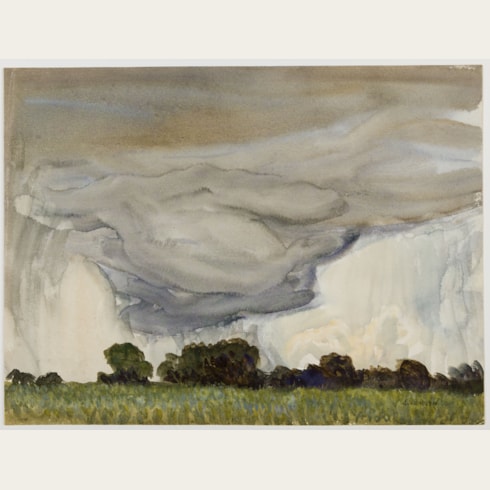George CLAUSEN
(London 1852 - Newbury 1944)
Study of Sea and Sky
Sold
Watercolour on white paper.
Signed G. CLAUSEN at the lower right.
255 x 316 mm. (10 x 12 1/2 in.)
Signed G. CLAUSEN at the lower right.
255 x 316 mm. (10 x 12 1/2 in.)
As a watercolourist, George Clausen produced both landscape studies and smaller variants of his oil paintings. He showed regularly at the Royal Watercolour Society, and in 1921 exhibited forty-one of his watercolours at the Grosvenor Gallery. Indeed, in the latter part of his career watercolours came to dominate his output. Writing in 1930, Clausen noted of his technique that ‘I try to work as simply and directly as possible in water-colour…I try (though, of course, I can seldom do it) to put the colour on in one wash, without re-touching, for I think there is nothing so beautiful as a clean tint in water-colour that is exactly right. And even if it does not exactly run into the right place (for water-colour is a tricky medium) the quality of the colour has something of the spontaneity and effortless rightness that one finds in Nature itself – a quality that is always lost by labouring and stippling a drawing...It seems to me that water-colour painting depends more on simplicity of method than oil-painting, and this means, of course, that you must know pretty well what you are want to do before you begin.’
Comparable atmospheric landscape watercolours by Clausen are in the Bury Art Gallery, the collection of Brinsley Ford, and elsewhere.
Comparable atmospheric landscape watercolours by Clausen are in the Bury Art Gallery, the collection of Brinsley Ford, and elsewhere.
George Clausen worked from age of sixteen as a draughtsman in a firm of decorators in London before winning a scholarship to the South Kensington Schools. A significant influence on the young artist was Jules Bastien-Lepage, whose work he first saw at the Grosvenor Gallery in London, and who inspired him to take up the theme of rural life as his subject matter. Working directly from nature, he painted scenes of rural life, and in particular the landscape and peasants of the farmlands of Essex. As one scholar has written, ‘His preoccupation was with light; the dazzle of sun on cornfields and haystacks and mowers at midday, the stilled radiance of blossom in orchards, the woods and empty fields at evening, and the subtle atmospheric effects in shadowy barn and stable.’
In 1886 Clausen exhibited at the New English Art Club, and by 1891 was showing at the Royal Academy, although he did not have a one-man gallery exhibition until 1902. By the 1890’s the influence of Bastien-Lepage had been tempered by that of Claude Monet and Edgar Degas, artists whom Clausen greatly admired. He was appointed a Professor of Painting at the Royal Academy Schools, and was elected an A.R.A. in 1895. He joined the Royal Watercolour Society in 1898, and became a Royal Academician in 1908. In 1926 he received a commission for a large mural for St. Stephen’s Hall in the House of Commons, and on its unveiling the following year received a knighthood. Clausen continued to enjoy a successful career until his death in 1944, at the age of ninety-two. A retrospective exhibition of his work at the National Gallery, proposed just a few months before the artist’s death, sadly never took place.
As a draughtsman, Clausen was a gifted and prolific master of different media, and some forty sketchbooks from throughout his long career survive. His drawings were often preparatory studies for his pictures, although their significance as works of art in their own right can be seen in the fact that, at his first one-man exhibition at the Goupil Gallery in London in 1902, he actually exhibited more drawings and pastels than oil paintings, with thirty-one of the former and twenty of the latter.
Provenance
E. Stuart-Smith (according to a label on the old backing board).
Exhibition
London, Royal Society of Painters in Watercolours (according to a label on the old backing board).





